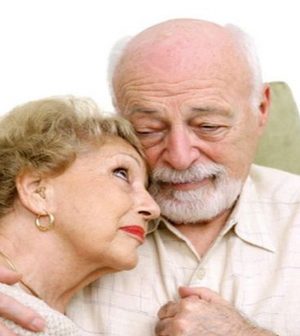- Navigating Your Midlife Crisis: Embracing New Possibilities
- City Raccoons Showing Signs of Domestication
- Mapping the Exposome: Science Broadens Focus to Environmental Disease Triggers
- One Week Less on Social Media Linked to Better Mental Health
- Your Brain Changes in Stages as You Age, Study Finds
- Some Suicide Victims Show No Typical Warning Signs, Study Finds
- ByHeart Formula Faces Lawsuits After Babies Sickened With Botulism
- Switch to Vegan Diet Could Cut Your Greenhouse Gas Emissions in Half
- Regular Bedtime Does Wonders for Blood Pressure
- Dining Alone Could Mean Worse Nutrition for Seniors
Caregiving Needs Double as End of Life Nears

TUESDAY, Aug. 22, 2017Reliance on caregivers doubles as people near death, and half of those caregivers — typically unpaid family members — report having no time for themselves, a new study indicates.
The research used a nationally representative sample of about 2,400 older adults in the United States. The study authors found that caregivers provided nearly twice the number of hours of help each week to dying individuals than to those not at the end of life.
“We were certainly aware when dealing with end-of-life care that families are mostly involved, but we couldn’t quantify that prior to this [research],” said study author Dr. Katherine Ornstein. She’s an assistant professor of geriatrics and palliative medicine at the Icahn School of Medicine at Mount Sinai in New York City.
More than 34 million Americans provided unpaid care to an adult aged 50 or older in the past 12 months, according to 2015 figures from the National Alliance for Caregiving and AARP. Most caregivers are female.
Ornstein and her team drew from two nationally representative surveys in which caregivers in the United States reported their experiences caring for dying adults over age 65. The researchers contrasted this data with that of other caregivers providing ongoing care.
Older adults were classified as being at the end of life if they died within 12 months of the surveys’ completion.
The study found that dying adults had an average of 2.5 caregivers assisting them. Those near the end of life received 61 hours of help per week compared to 35 hours of help per week for older adults who weren’t at the end of life.
More than one-third of the end-of-life caregivers reported physical difficulty related to their duties. Just over half reported having no time for themselves. These figures were 21 percent and 40 percent, respectively, for other caregivers.
Nearly nine in 10 caregivers are unpaid, according to the study. For end-of-life caregivers who were spouses, nearly two-thirds reported receiving no help from family or friends.
“What we see now is, on average, there are 2.5 people helping someone at the end of life. You can imagine if they don’t have that, it’s much more difficult,” Ornstein said. “When spouses are serving as caregivers, the majority are reporting doing it alone and have the [most challenging] consequences.”
Barbara Coombs Lee is president of Compassion & Choices, a Washington, D.C.-based advocacy organization for patients’ rights and end-of-life issues. She pointed out that the caregivers surveyed in the new study didn’t necessarily know ahead of time that the person they were caring for was at the end of life.
This lack of awareness may have increased caregivers’ stress levels, she said.
“This told me the caregivers were probably struggling, not knowing this was an end-of-life situation. Our [organization’s] research indicates that uncertainty about decision-making is an inherent and extremely powerful source of stress,” Lee said.
“I would guess that many of these people didn’t know they were dying … so they pursued heroic, torturous, futile treatment,” she added. “Often the default decision [to continue treatment] increases the caregiver burden.”
Ornstein said she hopes greater awareness of the family burden of caregiving, especially at the end of life, comes from her research.
“We need to think about expanding access to palliative care services, which can help facilitate the delivery of supportive services to families earlier,” she added. “And we can see how we need to provide more paid family leave so families can provide the support we’re pretty much expecting them to provide.”
Lee agreed with the need for expanded access to hospice and palliative care.
“One of the big barriers to access to hospice is [an] information gap,” Lee said. “People don’t understand that hospice is appropriate to them in their journey in their illness. Palliative care utilization would go up if people had more candid conversations and were privy to information that physicians have but aren’t sharing.”
The study was published recently in the journal Health Affairs.
More information
The Family Caregiver Alliance has helpful information for caregivers.
Source: HealthDay
Copyright © 2025 HealthDay. All rights reserved.










